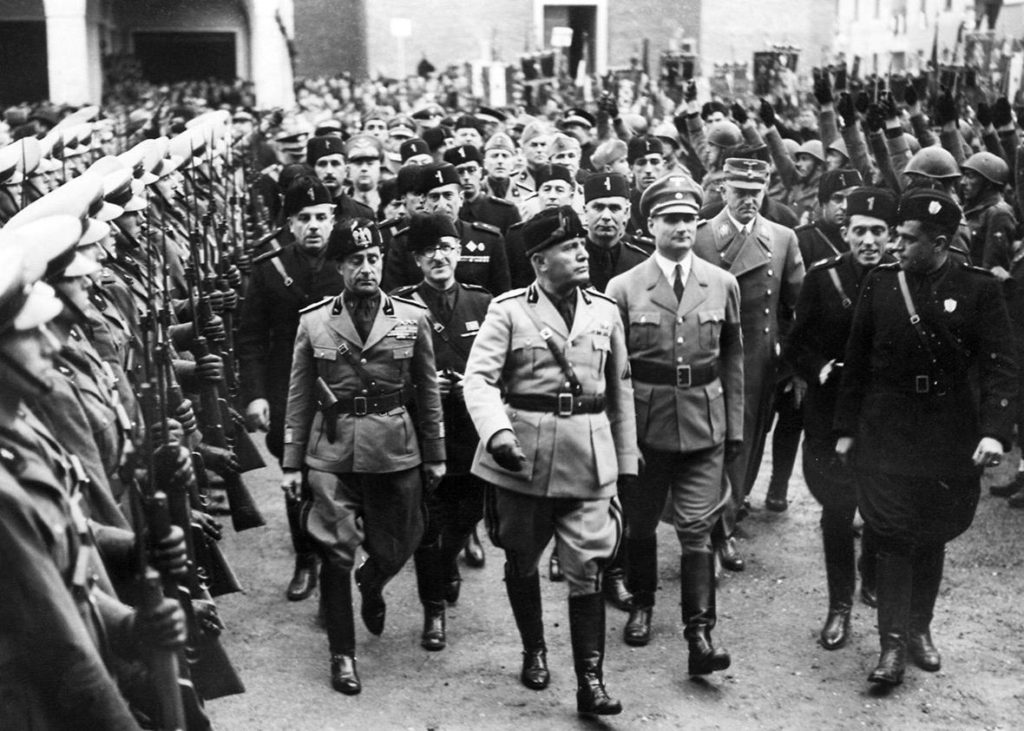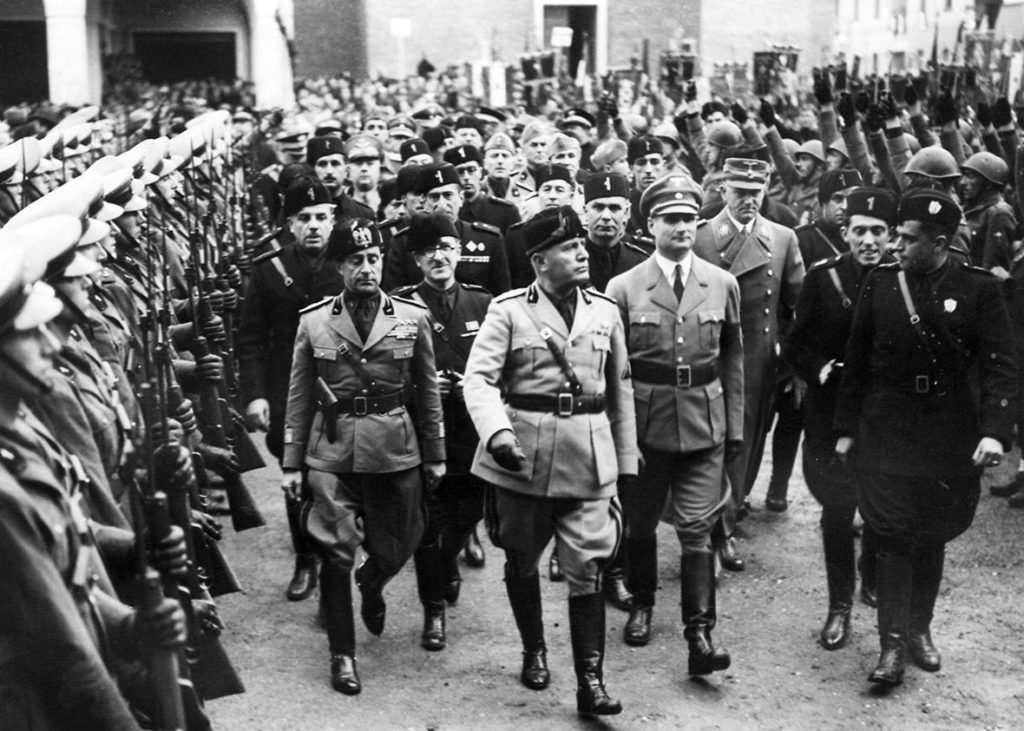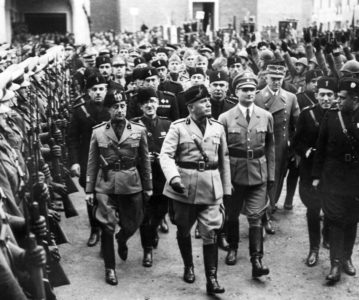Jacob Smith argues that if the left wishes to take fascism seriously we shouldn’t use the term lightly but with precision.

Some weeks ago Natasha Lennard, Intercept correspondent and author of a forthcoming book from Verso, Being Numerous: Essays On Non-Fascist Life, was making the rounds on lefty podcasts. While fascism was the topic of her conversations, Lennard pointedly declined to ever define the term or engage with the debate over its meaning and application. She seemed opposed, as a matter of principle, to narrow down a definition past mere linguistic descriptivism—treating “fascism” as “that which is called fascism”. I’m not sure what to make of a political writer who refuses to define her terms, and I am uncertain why anything that follows from that refusal should be taken seriously, but it would be a mistake to see her distaste for making distinctions merely as a personal idiosyncrasy. Declining to define the term “fascism” or defining it in extremely broad and all-encompassing ways has become common from the liberal center to the radical fringe.
Few political labels are as evocative or incendiary as “fascism.” Within some circles, it approaches being a generic derogatory term. Historically, however, the term is highly specific. It came out of a post-World War One, right-wing Italian nationalist movement, and the word itself refers to ancient Roman symbolism. Because of the close political alliance between the Fascist government of Italy and the Nazi party of Germany, “fascism” became a general term for violent far-right movements in Europe after WWI, usually including the governments of Hungary, Spain, and occasionally collaborationist states like Vichy France. The resemblance between these far-right movements emerged from similar circumstances: massive social upheaval and, most importantly, defeated workers’ revolutions. The historical markers of fascism include heavily armed paramilitary forces seizing state power and imposing brutal, anti-labor, anti-communist, and usually racist and sexist, regimes. Anti-semitism was common in historical fascist states but not ubiquitous and not limited to those fascist states.
In order for the term “fascism” to be useful, it cannot demand the exact replication of the historical circumstances of the 1920s and 30s, but it also cannot be so broad that it includes any and every violent, repressive, right-wing state. The term cannot be useful if it applies equally to Italy under Benito Mussolini, Germany under Otto von Bismarck, and India under the British Empire. It does not enhance our political theory to have a catch-all term for every form of capitalism that rejects liberal democracy.
Highly authoritarian governments with violent police forces are common in historical fascism, colonial empires, and military dictatorships. Brutally violent law enforcement and authoritarian dictatorship are far too common to be considered a mark of fascism. To include under the banner of “fascism” both Brazil under Michel Temer and the French Empire under Napoleon makes the term incoherent and meaningless. More importantly, it ignores the well-trod history of both liberal democracy and republicanism producing authoritarian police states, as in Brazil, and dictatorships producing otherwise progressive and liberal regimes, as in France. Just as there is no contradiction between police violence and capitalist liberal democracy, authoritarian dictatorships have not always had the other repressive and reactionary features associated with fascism.
The same is true of extreme, state-sanctioned, racism and sexism. In recent years China has carried out a project of ethnic replacement in Tibet and Xinjiang. Women are formal second-class citizens in the Gulf States. Legal segregation remained in full effect in the American South during Roosevelt’s New Deal. There is no form of political rule under class society that has not, at one time or another, produced a brutally racist and sexist state.
Although antisemitism is often considered a marker of fascism and most self-described fascists today are viciously anti-semitic, anti-semitism was actually the particular focus of only one historical fascist state, Germany, and prior to their defeat and the publicization of their crimes, anti-semitism was completely mainstream in European and American society. In order to understand the role that anti-semitism played in Nazi Germany, we have to have a deeper historical understanding of anti-semitism. Although it is often considered a form of racial or ethnic bias, the long history of anti-semitism in European society shows that it is not just a generic animus. Jewish people were not just shunned or ostracized as an underclass in the manner of racial minorities in the US or Dalits in India, they were feared and hated as an internal enemy of Christian Europe. This made Jewish people an ideal scapegoat for the far-right, as they could be attacked both as outsiders, subversive others, and as a fifth column, undermining the nation from within. Nazi ideology made anti-semitism one of its central components, but the ideas that underlie it and made the Holocaust possible were widespread, as evidenced by Jewish refugees being turned away from Britain, the US, and Canada, on explicitly anti-semitic grounds.
Although ethnic nationalism is not exclusive to fascism, a unique form of it is present in all varieties of fascism–from the 20th century through to today. Fascism in Germany and Italy held up “the nation” or “the people” as the right-wing answer to communist internationalism. By erasing the differences in interests between classes and proposing other antagonisms, ethnic or national, forming a political identity around the nation state allows for the creation of powerful and durable cross-class alliances. For the Nazis, this was an alliance between Germany’s industrial capitalists and middle class of shopkeepers, army officers, middle managers and government bureaucrats– an alliance that was able to crush the German labor movement and their political parties, the Social Democrats and Communists.
Against the internationalism of the Soviet Union and the German Communist Party, the Nazis constructed a radical nationalism, and the rest of Nazi ideology follows that pattern. With prominent Jewish leaders like Karl Marx, Rosa Luxemburg, and Leon Trotsky, communism was smeared as a Jewish plot, and the Nazis came to see the fight against communism and the fight against the Jewish population of central Europe as synonymous. In response to the radical egalitarianism of communism, Nazism became obsessed with societal hierarchies, which had both a racial component, the superiority of “Aryan” Germans to other races, and a sexual component, reinforcing the traditional societal roles of men and women and attempting to exterminate all sexual preferences and gender presentations that did not conform to those roles.
Repressive right-wing governments throughout modern history have displayed this kind of generic, across-the-board, reactionary, revanchist conservatism. What is unique about historical fascism is the class of people enacting it. In both Germany and Italy, the industrial capitalists materially and politically backed fascist movements, but the actual tool that expressed fascism’s power was the armed militias, the street-fighting formations that broke up the workers’ movement and forced the abdication of the liberal democratic governments. This is a different social force which results in a different political system than superficially similar projects enacted by military dictatorships and traditional capitalist parties.
Understanding fascism as an insurgent middle-class response to the threat of workers’ revolution helps explain the revival of fascism today. What we see is not a fully formed “fascist” movement, but glimmers of the same reactionary middle-class energy that animated the Blackshirts and the Brownshirts. To some extent this is a conscious development: organizations like the Proud Boys and the patriot militias look back to a time when their class defended a bourgeois order too “decadent and decayed”, to defend itself from the communist threat. Today, we do not see a fully developed fascist movement, just as we do not see a revolutionary workers’ movement, but both exist in embryonic form. The fascist organizations that do exist are fractious, tiny, and weak and they should not be conflated with the much larger, and less politically developed, right-wing populist movement that sees a democratic road to their objectives.
This is why it is a mistake to see Donald Trump and other far-right Republicans as “fascists.” They give cover to fascists, fascists are members of their coalition, but they are still happy to rely primarily on the owners of American capital, just as their supposed opponents, the Democrats, do. Trump was put in office by white, affluent, middle-class American homeowners voting for him, not by 200,000 armed militants marching on Washington DC. A political analysis that refuses to differentiate between those two things will lead to absurd and disastrous conclusions.
I have been involved in several attempts to form anti-fascist coalitions in my area and each has come to nothing as we were unable to agree, and barely even able to discuss, what the current threat of fascism consists of. There is a natural desire to unite in the face of our enemies, but political practices flow from political theory. If we do not carefully define “fascism” we cannot understand it, predict its development, and defeat it before it becomes the boot heel on our necks. If “fascism” is in power today, then the appropriate tactics are to organize workers’ militias and community self-defense organizations, bring together heavily armed and disciplined cadres, and directly assault fascists wherever we find them. If a real, fully developed, fascist movement is on the march, then socialists, communists, anarchists, and all other class-conscious workers are in a street war. This is objectively not the situation we face, but many dedicated anti-fascists act as if it is, and then express confusion and disdain when a different evaluation of contemporary fascism produces different tactics.
This is not to say that street mobilizations against fascists are unimportant. Public fascist organizing should be shut down, or at least meaningfully opposed, whenever possible. But even in these counter-demonstrations, our analysis of fascism is vital. Because the goal of these demonstrations is ultimately more propagandistic than combative, the opponent is “fascist ideas,” not “these particular fascists,” small bands of autonomous militants ready to punch some Nazis are far less valuable than masses of discipline demonstrators.
The real threat of fascism today—with the return of inter-imperial rivalries and the world economic situation continuing to teeter on the edge of a major collapse—is fascist ideas and organizations gaining a mass following. The threat is not that bands of reactionaries are off in the hills practicing marksmanship, but that the working class remains unprepared to act in its own interests. We lack mass workers’ parties, militant unions, or anything approaching mass revolutionary consciousness, and building those parties, those unions, and that consciousness is the best way to fight fascism today.




